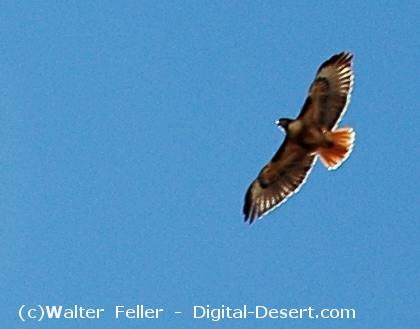Red-tailed Hawk
Buteo jamaicensisFamily: Accipitridae Order: Falconiformes Class: Aves
DISTRIBUTION, ABUNDANCE, AND SEASONALITY
Common, permanent breeding and winter resident and migrant. Breeds throughout
California, and winters in all areas without heavy snow cover. Found in almost all habitats,
from lowest to highest elevations.
SPECIFIC HABITAT REQUIREMENTS
Feeding: Eats small mammals up to hares in size,
small birds,
reptiles,
amphibians, and some carrion (Orians and Kuhlman 1956). In winter, largely dependent upon mice, but also
takes medium to fairly large birds on the ground. Catches small birds during migration.
Searches by soaring; also perches and pounces, or pounces on
prey
from low, quartering
flights, sometimes hovering on wind or air currents.
Cover: Feeds in grasslands and grass/shrub stages of most
habitats. Roosts in trees;
sometimes in dense conifer stands.
Reproduction: Usually nests in large trees near openings, in older, mature forests,
especially riparian deciduous habitats. Occasionally nests on cliffs or low ledges. Nests
9-21 m (30-70 ft) above ground in trees, higher on cliffs. Flexible in choice of nest site;
occasionally uses human-made structures, shrubs, cacti. Sometimes nests in isolated trees,
or in small groves in open habitat.
Water: Requirements probably met from food.
Pattern: Highly adaptable; uses grasslands, open brush habitats, and open stands of
deciduous and conifer forests. Also frequents croplands, fields, and pastures.
SPECIES LIFE HISTORY
Activity Patterns: Yearlong, diurnal activity. Most
active feeding occurs in early morning and late afternoon.
Seasonal Movements/Migration: Migrates downslope in winter; in summer and fall, some
individuals move to open areas at higher elevations.
Home Range: Home ranges vary from less than 1 to 10 km˛ (0.3 to 3.8 mi˛), depending on
location, topography, habitat, and prey availability.
Territory: In California, Fitch et al. (1946) calculated that territories varied from 0.3 to 0.8
km˛ (0.1 to 0.3 mi˛). They found 0.8 breeding pairs/km˛ (2/mi˛). Territory defended yearlong.
Reproduction: Courtship begins as early as January. Breeds March through July; peaking
in May and June. Clutch of 2-5 eggs, usually 2-3, laid in March and April. Incubates 28-32
days. Semialtricial young fledge in 40-45 days.
Niche: Adaptable, common, and widespread.
Scrub jays, and other avian and mammalian
predators, take undefended eggs and nestlings (Brown and Amadon 1968). May compete for
food with ferruginous, Swainson's, and rough-legged hawks. Great horned owls commonly
use old nests, and occasionally
golden eagles
do. Nestlings may be killed by blood-sucking
flies (Fitch et al. 1946). Golden eagles may prey on adult.
Source:
CDFW California Wildlife Habitat Relationships. Accessed [N/A]
https://wildlife.ca.gov/Data/CWHR

With a wingspan of up to 5 feet this conspicuous and
fierce looking bird of prey soars using the slight movement
of feather tips to guide its way within thermal uplifts to search
for victims. A Red-tail with its superb vision will fold its
wings against its body and power dive at speeds of up to 100
miles an hour to catch a variety of
lizards, snakes (including
rattlesnakes),
rodents
and every now and again, a
bird.
The Red-tailed Hawk is a raptor.
For more information on raptors, click here.
Also see >
Birds:
Carnivore:
Predators:
Diurnal
In the courtship display a pair of Red-tailed Hawks soars in wide circles at a great
height. The male dives down in a steep drop, then shoots up again at nearly as steep
an angle. He repeats this maneuver several times, then approaches the female from
above. He extends his legs and touches or grasps her briefly. The pair may grab onto
one other and may interlock their talons and spiral toward the ground.
When courting, a pair of Red-tailed Hawks soar in wide circles high above the ground.
The male will dive, then shoot up again. After repaeting this maneuver several times, he will
approach the female from above. He will extend his legs and touch or grasp her briefly. They may grab onto
each other, interlocking their talons and spiraling to the ground.
|
The Desert Food Chain * Everything has its niche. Who eats what, and what eats who in the desert? Click here to find out what more. |